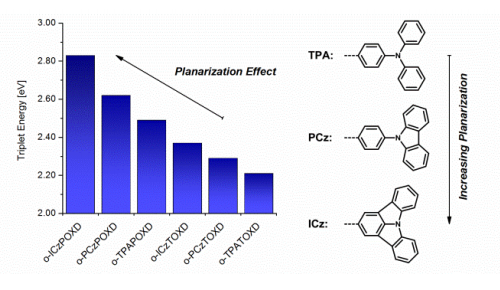-
Structure-Property Studies of P-Triarylamine-Substituted Dithieno[3,2-b:2',3'-d]phospholes
H. Puntscher, P. Kautny, B. Stoeger, A. Tissot, C. Hametner, H. Hagemann, J. Fröhlich, T. Baumgartner and D. Lumpi
RSC Advances, 5 (114) (2015), p93797-93807


DOI:10.1039/C5RA13651B | unige:77112 | Abstract | Article HTML | Article PDF

The synthesis of 10 novel P-substituted dithienophosphole oxide compounds applying phenylcarbazole and indolocarbazole donors is presented. Based on photo-physical and theoretical investigations, the study reveals that the pyramidal geometry of the phosphorus allows for the synthesis of charge transfer materials by introducing strong exocyclic donor groups but suppresses intramolecular charge transfer below a certain donor strength threshold, which is an appealing structural feature for the design of donor–acceptor materials. The triplet energies of the phenylcarbazole based compounds are in the range of 2.49–2.65 eV, sufficiently high for potential applications as host materials in PhOLEDs. By contrast, the introduction of indolocarbazole, the weakest employed donor, yields materials exhibiting a significantly higher triplet energy of up to 2.87 eV and a remarkably low singlet–triplet splitting (0.18 eV). In addition an interesting example of an intramolecular electronic through-space interaction has been observed for the ortho-linked phenylcarbazole derivative.

